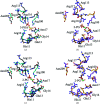Molecular insight into 2-phosphoglycolate activation of the phosphatase activity of bisphosphoglycerate mutase
- PMID: 35362470
- PMCID: PMC8972806
- DOI: 10.1107/S2059798322001802
Molecular insight into 2-phosphoglycolate activation of the phosphatase activity of bisphosphoglycerate mutase
Abstract
Bisphosphoglycerate mutase (BPGM) is an erythrocyte-specific multifunctional enzyme that is responsible for the regulation of 2,3-bisphosphoglycerate (2,3-BPG) in red blood cells through its synthase and phosphatase activities; the latter enzymatic function is stimulated by the endogenous activator 2-phosphoglycolate (2-PG). 2,3-BPG is a natural allosteric effector of hemoglobin (Hb) that is responsible for decreasing the affinity of Hb for oxygen to facilitate tissue oxygenation. Here, crystal structures of BPGM with 2-PG in the presence and absence of 3-phosphoglycerate are reported at 2.25 and 2.48 Å resolution, respectively. Structure analysis revealed a new binding site for 2-PG at the dimer interface for the first time, in addition to the expected active-site binding. Also, conformational non-equivalence of the two active sites was observed as one of the sites was found in an open conformation, with the residues at the active-site entrance, including Arg100, Arg116 and Arg117, and the C-terminus disordered. The kinetic result is consistent with the binding of 2-PG to an allosteric or noncatalytic site as well as the active site. This study paves the way for the rational targeting of BPGM for therapeutic purposes, especially for the treatment of sickle cell disease.
Keywords: 2,3-bisphosphoglycerate; 2-phosphoglycolate; X-ray crystallography; bisphosphoglycerate mutase; kinetics; phosphatases; synthases.
open access.
Figures




References
-
- Benesch, R. & Benesch, R. E. (1967). Biochem. Biophys. Res. Commun. 26, 162–167. - PubMed
-
- Benesch, R. & Benesch, R. E. (1969). Nature, 221, 618–622. - PubMed
-
- Bunn, H. F. (1997). N. Engl. J. Med. 337, 762–769. - PubMed
-
- Bunn, H. F. & Forget, B. G. (1986). Hemoglobin: Molecular, Genetic and Clinical Aspects. Philadelphia: W. B. Saunders.
MeSH terms
Substances
Grants and funding
LinkOut - more resources
Full Text Sources
Miscellaneous

